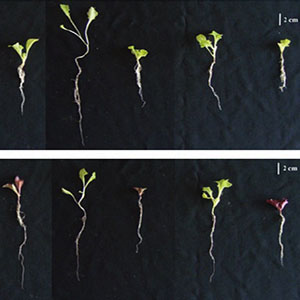In-door germination and seedling growth of green and red lettuce under LED-light spectrum and subsequent effect on baby leaf lettuce

Accepted: 26 May 2022
HTML: 186
All claims expressed in this article are solely those of the authors and do not necessarily represent those of their affiliated organizations, or those of the publisher, the editors and the reviewers. Any product that may be evaluated in this article or claim that may be made by its manufacturer is not guaranteed or endorsed by the publisher.
The spectrum and intensity of light play a significant role in the primary and secondary metabolism of plants. Low intensity can make the photosynthetic process less efficient, while inadequate spectrum can impair plant growth and quality. This study investigates the effect of different LED light spectra at low intensity on germination and growth of lettuce (Lactuca sativa L.) seedlings under a temperature-controlled chamber and the subsequent impact on mature plants grown in a greenhouse under natural light. The purpose was to reach a commercial plant seedling using a low amount of energy to achieve the yield potential in a shorter period. The experiment was carried out in three trials. In trial 1, the effect of different LED light wavelengths [100% blue (B); 100% red (R); mixed light 1 (52% blue, 27% green and 21% red) (BGR1), and mixed light 2 (29% blue, 53% green and 17% red and 1% far red) (BGR2)] at low intensity (55 μmol m–2 s–1 and 12 h light photoperiod) and darkness (control) on germination of two lettuce cultivars [‘Levistro’ (green) and ‘Carmolí’ (red)] was evaluated in a controlled temperature chamber (20±1.2°C). In trial 2, the effect of the same light conditions of the first experiment on agronomic characteristics and pigment contents of lettuce seedlings compared to the natural light (control: 451±66 μmol m–2 s–1) were evaluated. In trial 3, the seedlings developed under different LED light wavelengths were transplanted to evaluate the subsequent effect on the growth of baby lettuce cultivated hydroponically in the greenhouse under natural light. The results of this study show that red wavelength reduced germination percentage, while lights with a higher blue component (B and BGR1) accelerated germination and increased the number of germinated seeds in ‘Levistro’. Red also delayed germination and decreased the number of germinated seeds in ‘Carmolí’ compared to darkness. Seedlings of ‘Levistro’ had a higher fresh weight (FW) than ‘Carmolí’. In addition, FW increased under BGR2 and R, which coincided with the highest number of leaves and leaf length. Nevertheless, fresh weight was higher under BGR2 and B after transplanting, coinciding with the highest number of leaves. A higher blue component of the light (B and BGR1) increased the dry matter percentage (DMP) of seedlings, but there was no significant difference after transplanting. Chlorophyll (CHL) a and b content increased under BGR2; however, the highest CHL a/b ratio was observed under BGR1 in ‘Levistro’ and B in ‘Carmolí’, but it was higher after transplanting when seedlings were grown under B. The anthocyanin (ANT) content of ‘Carmolí’ seedlings was promoted by a higher blue component of the light (B and BGR1) but significantly increased under natural light (control) at the highest intensity. This work shows that varying the spectrum at low intensity can positively modify the growth and biochemical characteristics of lettuce seedlings, although the effect depends on the cultivar. This modification improves the performance of plants during greenhouse growth after transplanting, especially seedlings grown under B and BGR2.
Highlights
- Blue light enhanced germination and increased the number of germinated seeds of green lettuce.
- High blue component lights improved the morphology, dry matter percentage, and chlorophyll a/b ratio of lettuce seedlings.
- Blue and full-spectrum lights applied to lettuce seedlings affect fresh weight after transplanting.
- The anthocyanin content of seedlings was stimulated by blue light at 55 μmol m–2 s–1, but even more so by PAR of natural light at 451 μmol m–2 s–1.
How to Cite

This work is licensed under a Creative Commons Attribution-NonCommercial 4.0 International License.
PAGEPress has chosen to apply the Creative Commons Attribution NonCommercial 4.0 International License (CC BY-NC 4.0) to all manuscripts to be published.

 https://doi.org/10.4081/ija.2022.1982
https://doi.org/10.4081/ija.2022.1982







